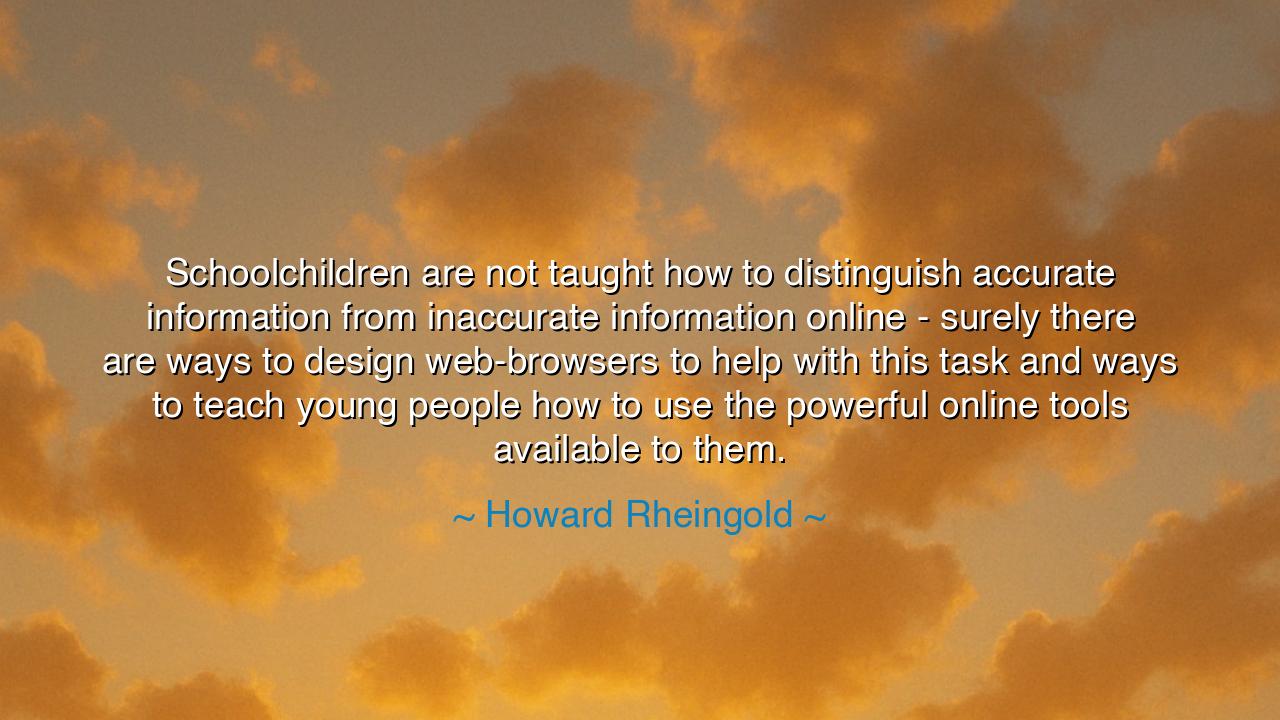
Schoolchildren are not taught how to distinguish accurate
Schoolchildren are not taught how to distinguish accurate information from inaccurate information online - surely there are ways to design web-browsers to help with this task and ways to teach young people how to use the powerful online tools available to them.






Hearken, O children of the digital age, and attend to the wisdom of Howard Rheingold, who declared: “Schoolchildren are not taught how to distinguish accurate information from inaccurate information online—surely there are ways to design web-browsers to help with this task and ways to teach young people how to use the powerful online tools available to them.” In this utterance lies a solemn warning for our times: knowledge is no longer guarded by parchment and stone, but by the vast currents of the unseen ether, where truth and falsehood intermingle like rivers converging. To navigate these waters, the young must be taught the sacred art of discernment.
Since the dawn of human learning, elders and scribes have labored to ensure that knowledge, when passed, was trustworthy and clear. The libraries of Alexandria, the halls of Nalanda, and the monastic scriptoria of medieval Europe served not merely to preserve texts but to cultivate wisdom, teaching disciples to distinguish the true from the false, the lasting from the fleeting. Rheingold reminds us that in the age of the internet, these ancient guardianship roles must be renewed, for the web is a vast and untamed domain, a place where both wisdom and deceit flourish.
The problem is urgent. Children now wield devices that connect them to the entire world, yet few are trained in the critical skill of evaluation. Like sailors set upon stormy seas without compass or map, they may be misled by false currents, guided to peril by seductive yet empty claims. Rheingold’s vision is a call to action: we must teach the youth not only to access knowledge, but to interrogate it, to weigh evidence, to recognize bias, and to discern the trustworthy from the deceitful. Only then can they use these tools as instruments of enlightenment rather than chains of confusion.
Consider the story of the Enlightenment, when scholars like Voltaire and Diderot compiled encyclopedias to disseminate verified knowledge. Their painstaking work reflects the principle Rheingold invokes: that education is incomplete without discernment. Knowledge alone is insufficient; it must be paired with judgment. Today, the web has become the new encyclopedia, but its contents are uncurated, a labyrinth without sentinels. The tools exist to navigate it, but the art of their use must be taught.
Rheingold also reminds us that design matters. Just as the printing press amplified the power of ideas centuries ago, so too can web-browsers be crafted to guide users toward accuracy, highlight sources, and illuminate credibility. Thoughtful design can act as the hand of the teacher, gently steering young minds toward the truth, helping them to cultivate habits of inquiry and caution in a world of endless information. The tools themselves can be allies in the noble pursuit of wisdom.
O seekers, learn from this vision. It is not enough to provide access to information; one must cultivate the capacity for judgment and discernment. Teach your children to question, to probe, to seek evidence, and to respect knowledge as a living force that demands care. Encourage them to use technology as an instrument, not a master, and to approach each claim with curiosity tempered by caution. The future depends not only on what they learn, but on how wisely they wield the knowledge entrusted to them.
The lesson endures: wisdom cannot be inherited, only nurtured. The web, like the vast libraries of the past, is filled with light and shadow, truth and falsehood. Equip the young with both the tools and the insight to navigate it, and they shall rise as citizens of discernment, capable of shaping the world with clarity, integrity, and courage. Let the elders be vigilant, the teachers be vigilant, and the designers of technology be vigilant, for together they may ensure that the flame of understanding is not extinguished by the winds of confusion.
Thus, Rheingold’s words resonate across time: education and design must unite to guide the young in the age of information, so that the torrents of knowledge flow not to chaos, but to wisdom. Let every device, every browser, and every lesson be a beacon of clarity. Let every child learn to walk through the digital expanse with eyes open, hearts wise, and minds sharp, for in their discernment lies the hope of a world where knowledge brings understanding, not illusion.
If you wish, I can also craft a short illustrative story of a young student navigating the web wisely versus one misled by misinformation, bringing Rheingold’s vision vividly to life for listeners. Would you like me to do that?






AAdministratorAdministrator
Welcome, honored guests. Please leave a comment, we will respond soon